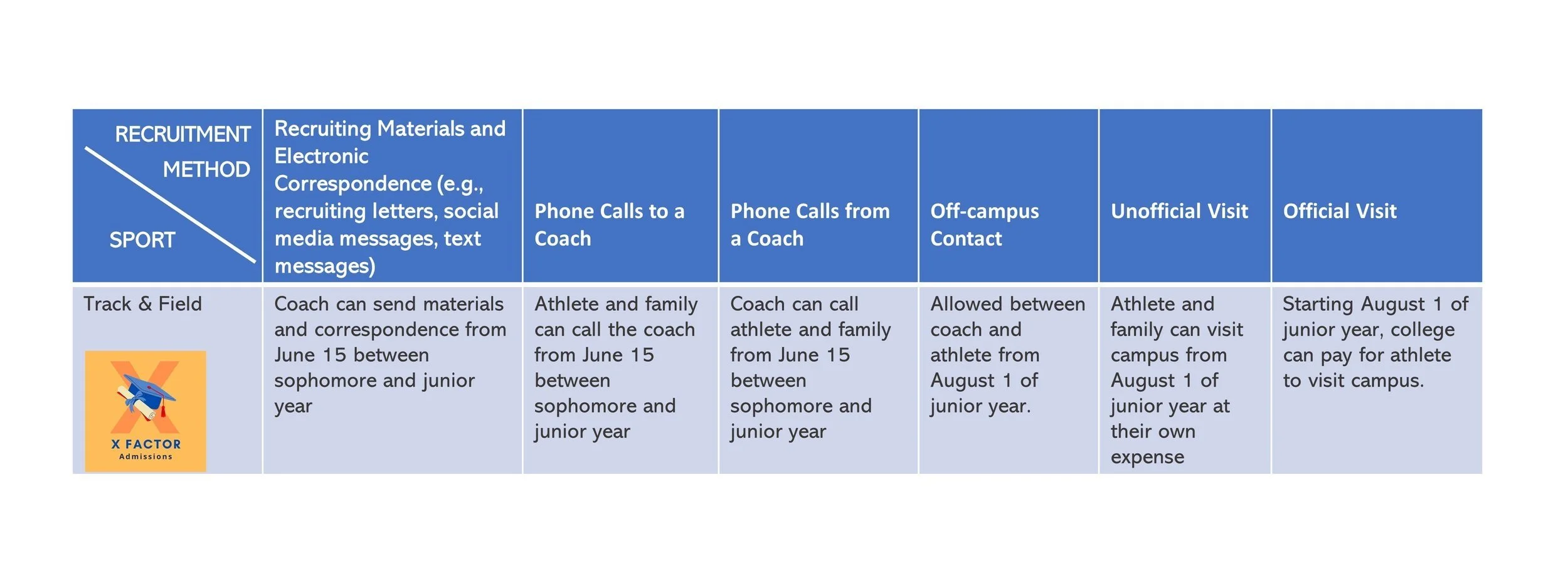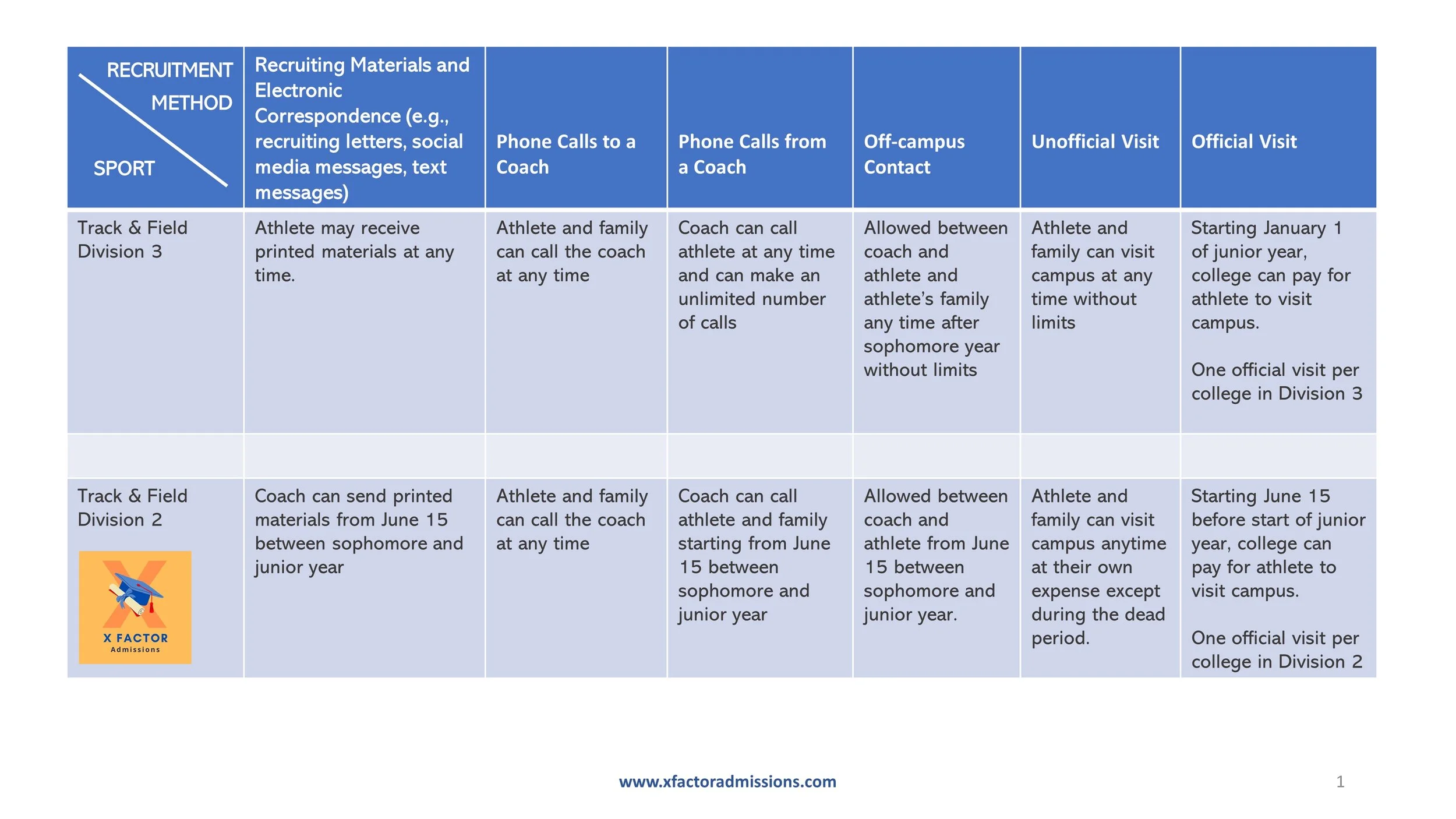Track & Field: NCAA Rules of Athlete Recruitment
INTRODUCTION
It is the dream of many parents for their child get recruited onto the sports team of elite colleges like Harvard, Yale or Columbia. After all, athlete recruitment is one of the few avenues there are to bypassing the conventional route for admission to the highly selective colleges.
Before starting, it is important for both parents and recruits to know that there are a number of rules that they and their high school/club coaches must comply with, in addition to the stress of deciphering which NCAA coaches would be open to considering your runner for recruitment to the team. When you start these conversations with coaches and when you can speak in-person with the head coaches of NCAA track teams is also determined by a recruiting calendar, which will be explained in detail below.
From when you first reach out to the head coaches, to periodically reporting your progress, to speaking with the head coaches during unofficial campus visits, to then official campus visits, all communications with Division I head coaches fall under precise rules set by the NCAA and a recruitment calendar.
Division 2 colleges, while still having to follow NCAA eligibility rules, have much more relaxed regulations regarding contact and the academic calendar.
Rules regarding Division 3 are even more relaxed. Athlete recruitment as it applies to Division 3 is substantially different from Division 1 and 2 because recruits are admitted mostly based on their academic performance, and not their accomplishments in sports. Many Division 3 coaches suggest their recruits submit an ED application, followed by a notice from the coach to the office of admissions that the applicant has been pointed out for the track & field team. Eligibility varies by college.
RECRUITING CALENDAR AND RULES
The foremost task of a prospective NCAA track & field athlete recruit is getting to know the rules regarding contact between an athlete and an NCAA coach about recruiting you to their track team. These rules include:
when you can initiate a discussion with a head coach,
when head coaches can initiate discussion with you,
where and when you can begin in-person communication with a head coach
the medium of communication (phone call, e-mail, text, in-person)
the content of the interaction (particularly, when you can speak about recruitment)
the distinction between “official” and “unofficial” visits
when are unofficial visits allowed
when are official visits allowed
when is contact disallowed during the recruitment cycle
Whenever a coach says more than “Hello” to the athlete or his/her parents during a face-to-face interaction off-campus, a “contact” is made, according to the NCAA. The rules surrounding contact are very rigid. Many Division 1 NCAA coaches approach cautiously and will absolutely not interact with parents or runners at competitions beyond a simple “hello” until between the runner’s junior and senior year.
The rules and calendar vary between Division 1, Division 2 and Division 3 colleges, so please pay careful attention to which Division a college that you are interested in belongs.
Division 1 Track & Field Athlete Recruitment Rules and Calendar
Freshman and Sophomore Year
At any time, an athlete may receive recruitment surveys, camp brochures and non-sports institutional publications from Division 1 coaches.
Junior Year
June 15th before junior year: Contact, which includes texts, phone calls, emails, and social media communications, between an athlete or their parent and an NCAA coach, is permitted after this date.
NCAA coaches are prohibited from mentioning recruitment to a college with an athlete, their parent, the club the athlete attends, or their high school coach until after this date. The NCAA coach cannot extend verbal offers that imply the athlete may receive a scholarship. The scope of the conversation is limited to if a club or high school coach asks an NCAA coach if they are recruiting the athlete, to which the NCAA college coach may say “yes” or “no”.
August 1: Off-campus contact between coaches and athletes is now allowed. Recruits can also officially tour college campuses. An official visit includes any visit to a college campus in which most or all of the visit - such as meals, transportation and tickets, are provided for by the athletic department of the college.
Recruits can also conduct unofficial visits to college campuses. These are paid for entirely by the recruit and their family and serve as a way to get acquainted with the various campuses and meet the head track & field coaches at their respective colleges.
Senior Year
Except for designated “dead periods”, there are no restrictions on contact between the head coaches and the potential athlete recruit.
Recruitment Calendar
At the Division 1 and Division 2 levels, various types of contact with college coaches are permitted at specific periods. Figure out what type of contact you can expect based on your age and the season by placing the NCAA Division 1 recruiting calendar for 2022-2023 and the NCAA Division 2 recruiting calendar for 2022-2023 on top of the recruiting rules.
There are exceptions where dead periods overlap with contact periods. Check the calendar to know when these take place.
Dead Periods
Potential men and women’s water polo recruits must also observe the “dead periods” of the recruitment calendar.
A Dead Period is defined by the NCAA as that period of time where conducting in-person (face to face) recruiting contacts or evaluations on or off the campus are not allowed, and the colleges are not allowed to conduct official or unofficial visits for potential recruits to the campus.
Nov. 8-11, 2021
Nov. 20, 2021
Dec. 13-Jan. 1, 2022
Mar. 11-12, 2022
June 8-11, 2022
Contact Periods
Contact Period (Recruiting Period): A contact period is the time frame during which coaches may make in-person (face to face) contact with athletes and evaluate potential recruits off-campus.
Aug. 22-Dec. 12, 2022
Jan. 2-July 31, 2022
Evaluation Periods
Evaluation Period: An evaluation period is when authorized athletics department staff members are allowed to participate in off-campus activities to evaluate potential student-athletes' academic credentials and playing skills. During an evaluation period, no face-to-face off-campus recruiting contacts may be conducted with the potential student-athlete.
Aug. 1-21, 2021
Track & Field Division 1 Athlete Recruitment Timeline Chart
Division 2 Track & Field Athlete Recruitment Rules and Calendar
Note that there are no highly selective colleges in NCAA Division 2
Freshman and Sophomore Year
Rules regarding Division 2 athletic recruitment are less strict than for Division 1.
At any time, a Division 2 track & field athletes can conduct unofficial visits to college campuses before official contact starts between the athlete and the NCAA coach. Just like with Division 1, athletes may be given recruiting questionnaires, general camp brochures, and non-athletic recruiting publications.
Junior Year
Before junior year on June 15: NCAA coaches are permitted to contact athletes via phone calls, texts, emails, social media direct messages and more. Coaches can send athletes institutional publications, along with all other recruiting materials. Athletes can begin making official campus visits, while coaches can begin meeting with recruits off-campus.
Dead Periods
November 7 (7 a.m.) to 9 (7 a.m.), 2022, (over the 48 hours before the National Letter of Intent signing at 7 a.m.)
Contact Periods
All periods not designated as “dead period” should be treated as contact periods.
Division 3 Track & Field Athlete Recruitment Rules and Calendar
Freshman and Sophomore Year
Division 3 rules are by far the most relaxed for NCAA athlete recruitment.
Athletes may be given recruiting questionnaires, general camp brochures, and non-athletic recruiting publications at any time.
Coaches may begin speaking back and forth with athletes by giving them phone calls, text messages, emails, social media DMs and messages and more at any time.
Athletes may conduct unofficial campus visits at any time.
After the end of an athlete’s sophomore year, NCAA coaches may reach out off-campus to an athlete at their high school or in their home.
Junior Year
January 1: Athletes may make one official visit per college.
Senior Year
There are no restrictions on the potential athlete recruit or head coaches on contact.



